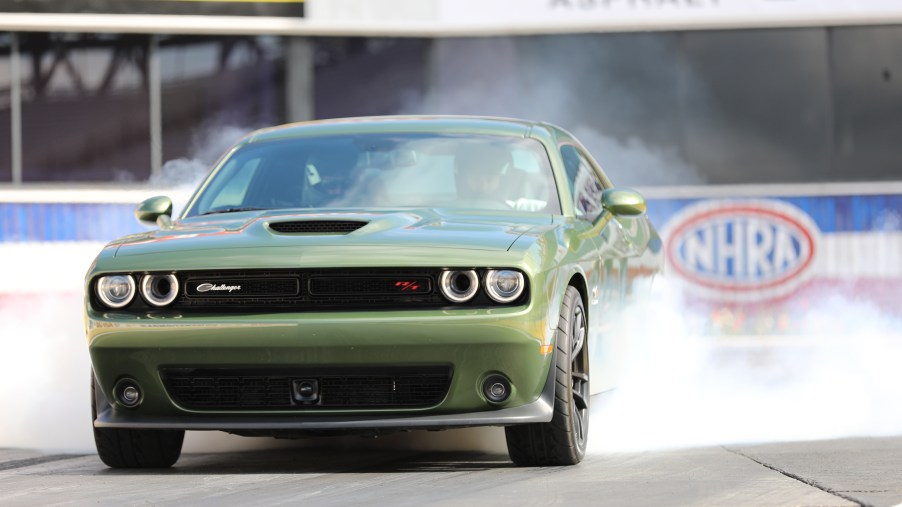
Mustang GT vs Challenger 1320: Which Is Faster?
Two legendary muscle cars go head-to-head in a race. Both are quick as they roar off the first line. Brand fans think they know which car should be faster. If you try to be objective, though, it might be hard to predict the winner.
The two cars vying for position are the 2019 Ford Mustang GT and the 2019 Dodge Challenger R/T Scat Pack 1320. The venue is a quarter-mile NHRA-sanctioned drag strip at Mission Raceway Park in British Columbia, Canada. Before we reveal the winner, let’s look at what these big-engined beasts bring to the competition.
Mustang GT Specs
With 460 hp and 420 lb-ft of torque, the 2019 Mustang GT is a pony that packs plenty of punch. The classic 5.0-liter Coyote V8 engine powers this car, boasting a zero to 60 mph in just under four seconds. It comes standard with a six-speed standard transmission. A 10-speed automatic transmission with paddle shifters is available, which the automaker claims is even faster.
The Mustang GT has a curb weight of 3,705 pounds, which is about 450 pounds lighter than its contender in this race, the Challenger.
To boost the rear-wheel-drive Mustang’s already impressive performance, Ford offers a choice of two performance packs. Performance Pack Levels 1 and 2 both improve handling and braking for track and road courses and for straight-line racing to a lesser extent. The six-speed manual Mustang GT in the video appears to be equipped with Performance Pack Level 1.
This package includes an extended lower lip spoiler on the front end for improved downforce that helps the car grip the road. The spoiler also scoops up more air to the radiator which, in turn, cools the engine and enhances performance. Two functional heat extractors on the hood aid in cooling the engine as well. A carbon rear wing is also part of this package, and it’s significantly larger than the integrated spoiler that comes standard on the GT.
Nineteen-inch, nine-inch-wide wheels keep the Mustang on the track. Giant, sticky Michelin Pilot Sport 4S tires also help the car create a bigger contact patch with the road. Six-piston, 15-inch Brembo brakes offer superior braking.
Another performance-focused part of the Performance Pack Level 1 is a 3.73 axle ratio that reduces the lag when a driver when shifts from first to second gear. Also included in this package is a Torsen limited-slip differential, which reduces wheel-spinning and improves launch in a muscle car like the ‘Stang.
Handling is further improved with independent rear suspension. The car also has a strut tower brace under the hood to stiffen the suspension of the front end.
Challenger Scat Pack 1320 Specs
If you decode the terms in this car’s name—the 2019 Dodge Challenger R/T Scat Pack 1320—it actually tells you quite a bit about its performance. R/T stands for Road/Track, which means that Dodges race both on the streets and in NASCAR competitions. Dodges that are designated as R/T models have a robust engine and performance-based suspension, tires, and brakes.
Scat Pack is a riff off of Frank Sinatra’s “Rat Pack”. It refers to the Charger and the Challenger collectively. More significantly, Dodge says that the Scat Pack includes cars that can run a quarter-mile in 14 seconds or less. The last term, 1320, refers to 1,320 feet, the length of a quarter-mile.
If the name wasn’t enough of a clue, the specs on the 1320 tell you everything you need to know about its racing DNA. Under its hood lurks a 6.4-liter 392-cubic-inch Hemi V8 engine. It gives this chunky, powerful car the juice to churn out 485 hp and 475 lb-ft of torque. And its 0-to-60 mph time matches the Mustang’s at 3.9 seconds.
The standard Tremec six-speed manual transmission from 2018 has been updated to a predictable, faster-shifting ZF eight-speed automatic transmission with manual shifting mode. U.S. drivers can opt for the six-speed stick but will pay a $1,000 gas guzzler tax for it.
The 1320 can launch hard from the start line thanks to the adaptive dampers that activated when the car is in Drag driving mode. These allow additional rear weight transfer that pushes the car forward. A torque reserve system that controls the fuel flow to the car’s cylinders and balances engine rpm and torque delivers optimal power and launch.
The TransBrake is a secret weapon lifted from the recently retired 808-hp Challenger SRT Demon. It locks the transmission output shaft while the engine is revving to keep the car stationary before a standing start.
For ultimate acceleration, the 1320 also has an asymmetric limited-slip differential with a 3.09:1, another element that’s been borrowed from the Demon. Add some 20-inch, 9.5-inch wide forged-aluminum wheels plus enormous street-legal Nexen SUR4G radial tires for fun. The 1320 is ready to try for the 11.7-second quarter mile at 115 mph heat that Dodge says this car can do.
Drag Race
Now you have the specs for both of these amazing muscle cars. Each has its strengths, and the driver who knows how to make the most of them will have a competitive edge. But take a look at the YouTube video and check out which car is faster. Is it the car you thought would win?


